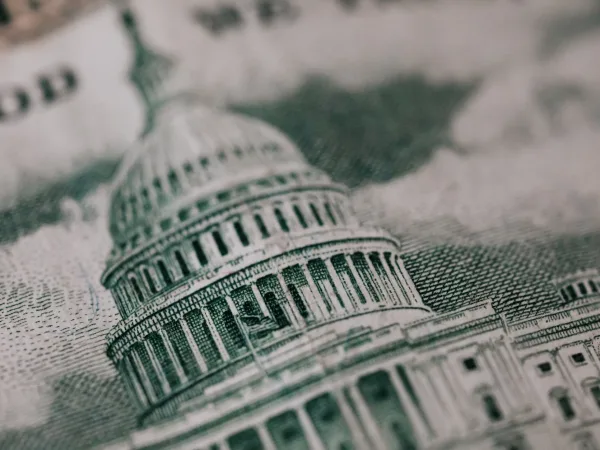Estimated reading time: 13 minutes
Burning the American flag has long been one of the country’s hot-button issues, guaranteed to spark debates at dinner tables and in courtrooms alike. Some view the act as the ultimate exercise of free speech, a fiery demonstration of personal liberties enshrined by the First Amendment of the Constitution. Others see it as an unforgivable affront, a symbolic attack on the nation’s values and those who have fought under its banner.
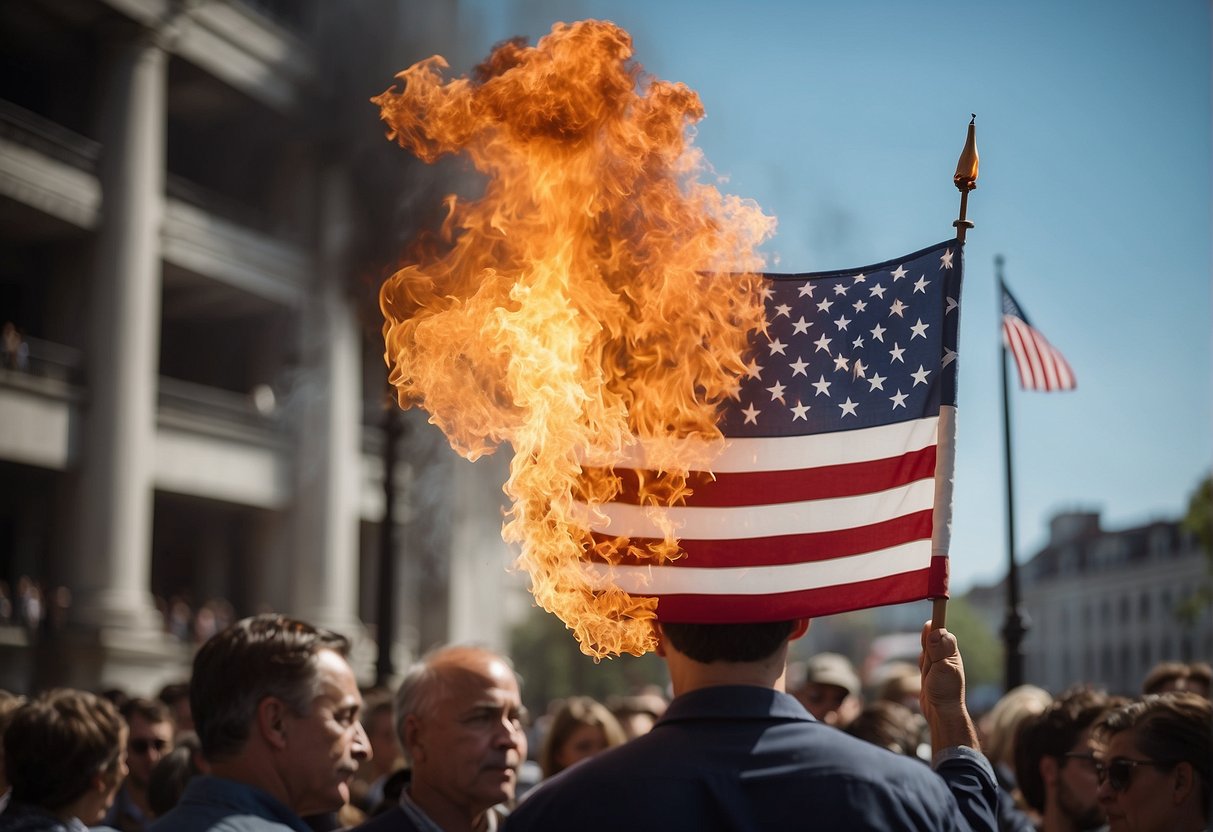
Historically, the Supreme Court has entered the ring more than once to referee this ideological tussle. The Court decided in landmark cases that the right to torch Old Glory in protest is a form of expression protected by that very same Constitution that stitch for stitch creates the flag. It seems the justices concluded that, while the flag is a symbol of freedom, preventing someone from turning it to ash would amount to irony on a national scale.
This topic has not faded over the years, as the interplay between patriotic symbolism and the freedom of expression remains as combustible as the material of the flag itself. Whether it should be illegal to burn the American flag dives into questions about the breadth of liberties and the limits of patriotism – a smoldering debate indeed.
Historical Heat: The Legal Timeline of Flag Desecration
The American flag has been at the center of a fiery debate culminating in landmark Supreme Court decisions. This section turns up the heat on the legal battles over whether burning the star-spangled banner should send you to the cooler or be a cause for cheer under free speech.
The Great Flame of 1989: Texas v. Johnson
In 1989, the stars were not aligned for the Texas statute criminalizing flag desecration. Gregory Lee Johnson found himself in hot water for burning an American flag outside the 1984 Republican National Convention in Dallas, which he did as a form of political protest. The case Texas v. Johnson sizzled all the way up to the Supreme Court. In a 5-4 decision, the Court extinguished the Texas law, declaring that flag burning constitutes symbolic speech protected by the First Amendment.
United States v. Eichman: When the Supreme Court Kept Its Cool
Congress decided to turn the heat back on after Texas v. Johnson by passing the Federal Flag Desecration Law in 1989. However, this attempt to douse the flames of flag burning activism didn’t last long. The Supreme Court had to chill the situation again in United States v. Eichman in 1990. The same razor-thin 5-4 verdict held that the government could not prosecute individuals for burning the flag, reaffirming that such actions were cozy within the warm embrace of free speech rights.
To Burn or Not to Burn: Protecting Our Stars and Stripes
The burning question—pun intended—is whether the American flag should enjoy immunity from the flames. Dive right into the fiery debate about the legality of setting the Stars and Stripes ablaze.
The Flag Protection Act of 1989: A One-Hit Wonder
The Flag Protection Act of 1989 swaggered in like a sheriff in a lawless town, eager to handcuff anyone daring to torch Old Glory. The act, brief as a pop star’s first hit, declared burning the American flag a no-go zone. Yet the Supreme Court, with a star-studded soundtrack of freedom of speech, quickly reminded everyone that the Constitution is not to be upstaged, leading to the act’s unceremonious bow out in 1990.
Flirting with Change: The Flag Desecration Amendment Rendezvous
When it comes to amendments, Congress loves to tango. They came this close to passing the Flag Desecration Amendment multiple times. Picture Congress by the punch bowl, trying to catch the eye of two-thirds of its members—plus the states enough to ratify—hoping for a constitutional amendment dance-off to protect the flag. Alas, the amendment remains a wallflower, with the Constitution not yet swiping right on flag protection.
Swearing by the Flag: A First Amendment Romance
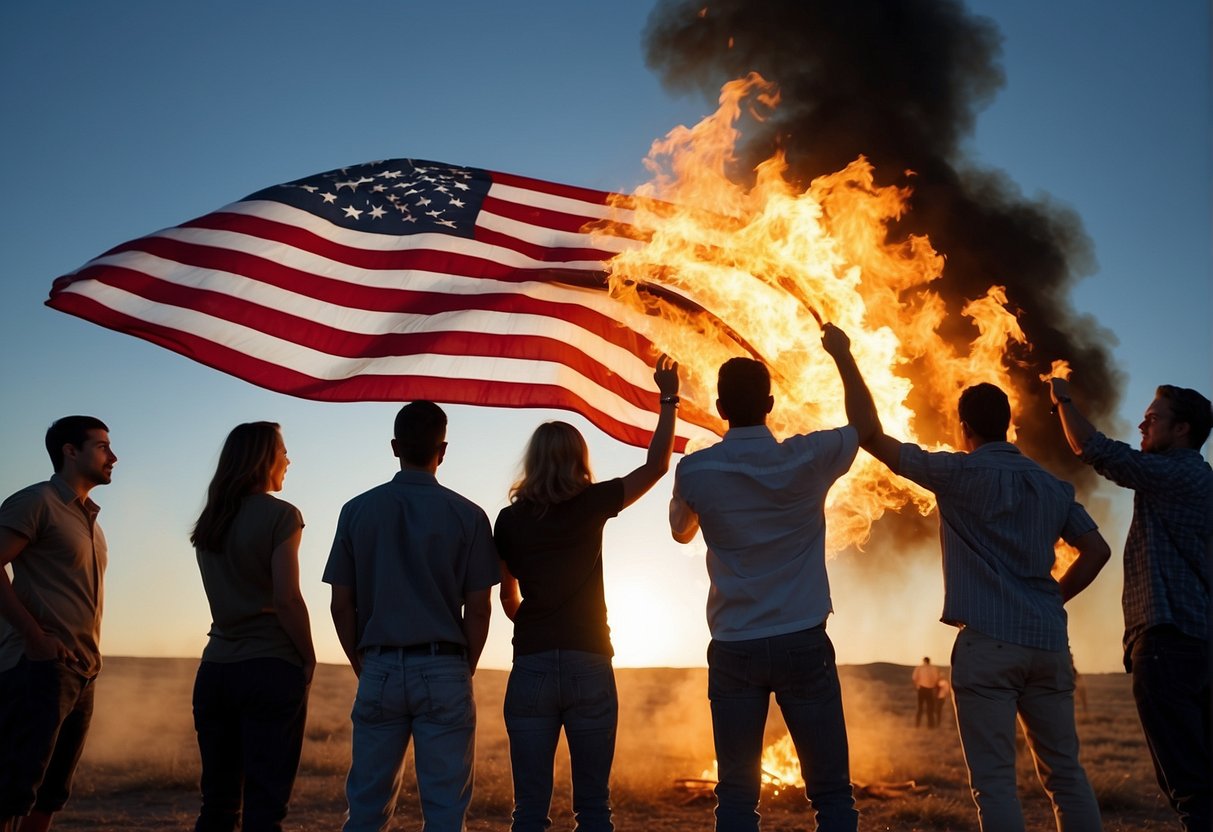
In the tempestuous affair between free speech advocates and patriotic sentiment, the Supreme Court has been the ultimate matchmaker, determining if flag burning should be a love letter to free speech or a deal-breaker for national pride.
Burning Love for Free Speech
In the sultry summer of ’89, the U.S. Supreme Court got steamy with the First Amendment in the landmark case Texas v. Johnson. Justice William Brennan, playing Cupid for constitutional rights, penned an impassioned majority opinion — a love note, if you will — which affirmed that burning the flag was a form of expression ardently protected by the First Amendment. Yes, even acts that singe the symbols of national unity were taken into the warm embrace of free speech.
Justice Flirts with Dissent: Supreme Court Opinions
Justice Anthony Kennedy, while admittedly not thrilled to watch Old Glory light up like a Fourth of July sparkler, flirted with his libertarian instincts and concurred that personal distaste must be spurned in favor of constitutional love affairs. Freedom of speech, it seems, was a seductive mistress, capable of coaxing even the most reluctant justices into the dance of dissent and dialogue, securing her status as the belle of the Bill of Rights ball.
Lighting the Fire Under Congress: Legislative Reactions to Flag Burning
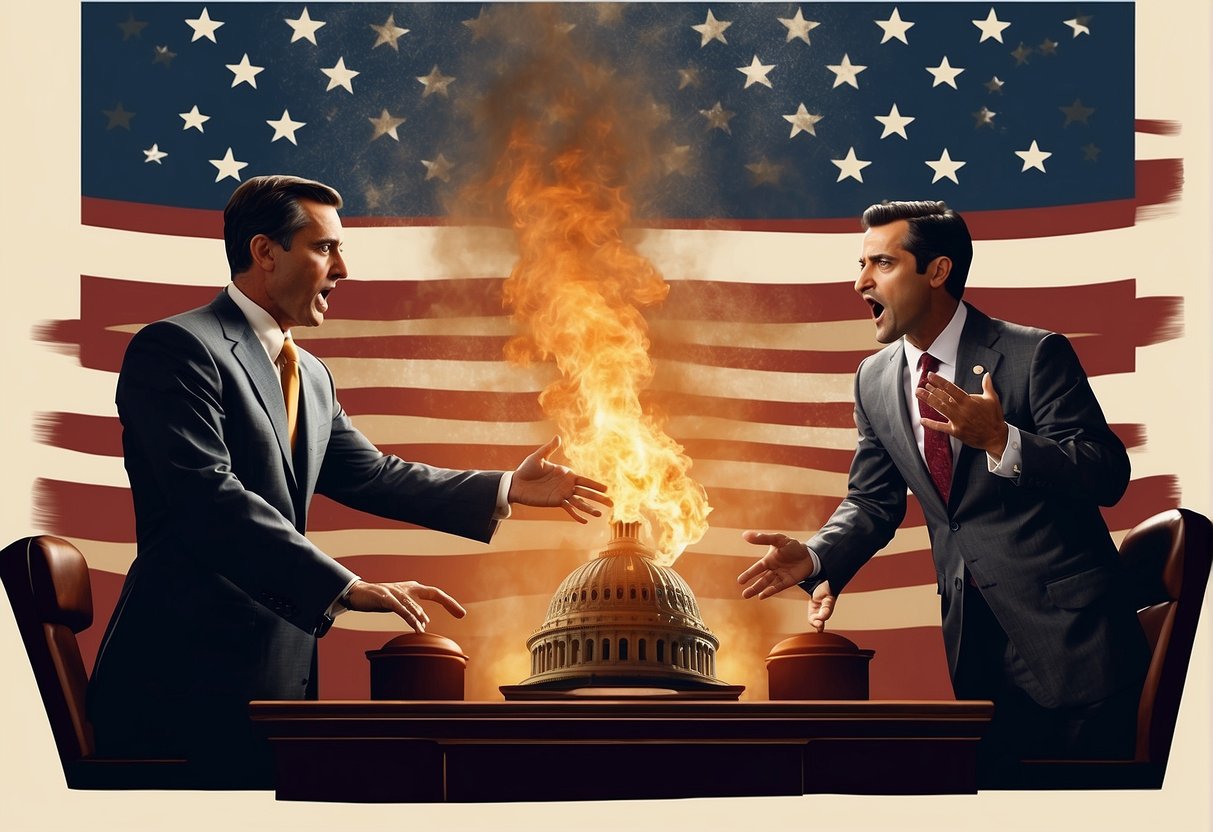
Congress has often found itself in a heated tango with the combustible issue of flag burning. The legislative body has sparked numerous attempts to outlaw the act through various bills and resolutions, yet the flames of debate persist.
Attempting to Douse the Flames: Congressional Bills and Resolutions
Since the fiery protests of the Vietnam era, Congress has been fanning the flames of legislation aimed at protecting Old Glory from being reduced to ashes. In 1968, the Federal Flag Desecration Law made its way through the halls of Congress, making it illegal to publicly mutilate, deface, burn or trample upon the flag. However, this law would later be challenged and extinguished by Supreme Court decisions.
Not one to watch their efforts go up in smoke, Congress struck back with the Flag Protection Act of 1989, which essentially attempted to reinforce the earlier prohibitions. It declared it a no-no to desecrate the flag, regardless of whether one’s intentions were as pure as Uncle Sam’s heart or as rebellious as a teenager listening to rock ‘n’ roll.
| Year | Legislation | Description |
|---|---|---|
| 1968 | Federal Flag Desecration Law | Prohibited flag desecration by publicly mutilating, defacing, burning, or trampling. |
| 1989 | Flag Protection Act of 1989 | Made it unlawful to maintain a U.S. flag on the floor or ground or to physically defile such flag. Intended to cover all bases on flag misbehavior. |
Playing with Matches: Politicians’ Stances on Flag Desecration
Politicians over the years have played with matches near the tinderbox of public opinion on flag desecration. Some view the flag as a sacred emblem deserving of absolute reverence and protection under federal law. Others argue that flag burning, while not exactly a hobbyist’s dream, should be protected as a form of free speech under the First Amendment—a right as American as apple pie.
They teeter back and forth on the issue, holding varying stances as if choosing between barbeque and lighter fluid at a Fourth of July cookout. Their positions often reflect the mood of their constituents and can ignite passionate discourse both in the corridors of power and at the backyard fences of America.
A Patchwork of Patriotism: State Laws vs. National Symbols
Before an intrepid traveler marches through the legal landscape of American flag desecration laws, it’s crucial to understand that state laws and national symbols engage in a complex, constitutional tango.
State Law Smoldering: A Fraught Relationship
The tie between state laws and the idea of flag desecration burns with a contentious fire. Individual states, like Texas, often had their laws singed around the edges by the federal breeze. For instance, before the infamous Texas v. Johnson showdown in 1989, it was a wee bit illegal in Texas to torch the star-spangled banner. But post-1989, the Supreme Court gave a stern “No-go!” to state laws that tried to criminalize flag burning, declaring such acts as free speech under the First Amendment. A bit of a snub to state sovereignty, some say, but hey, free speech is free speech.
Flag Fever: The Search for Uniformity
Now, the United States, being a melting pot of opinions, isn’t one to let the states have all the mismatched fun. After the Supreme Court fanned the flames with rulings protecting flag desecration as a First Amendment right, federal law had to step up to the barbecue. The Flag Desecration Law of 1968 tried to plant a flag firmly against public mutilation of the national symbol, yet here we are, decades later, with a Supreme Court stance that essentially says, “Let it burn — if you must express yourself that way.” Uniformity in law? More like a barbecue patchwork quilt.
Express Yourself or Suppress Yourself: The Public Square
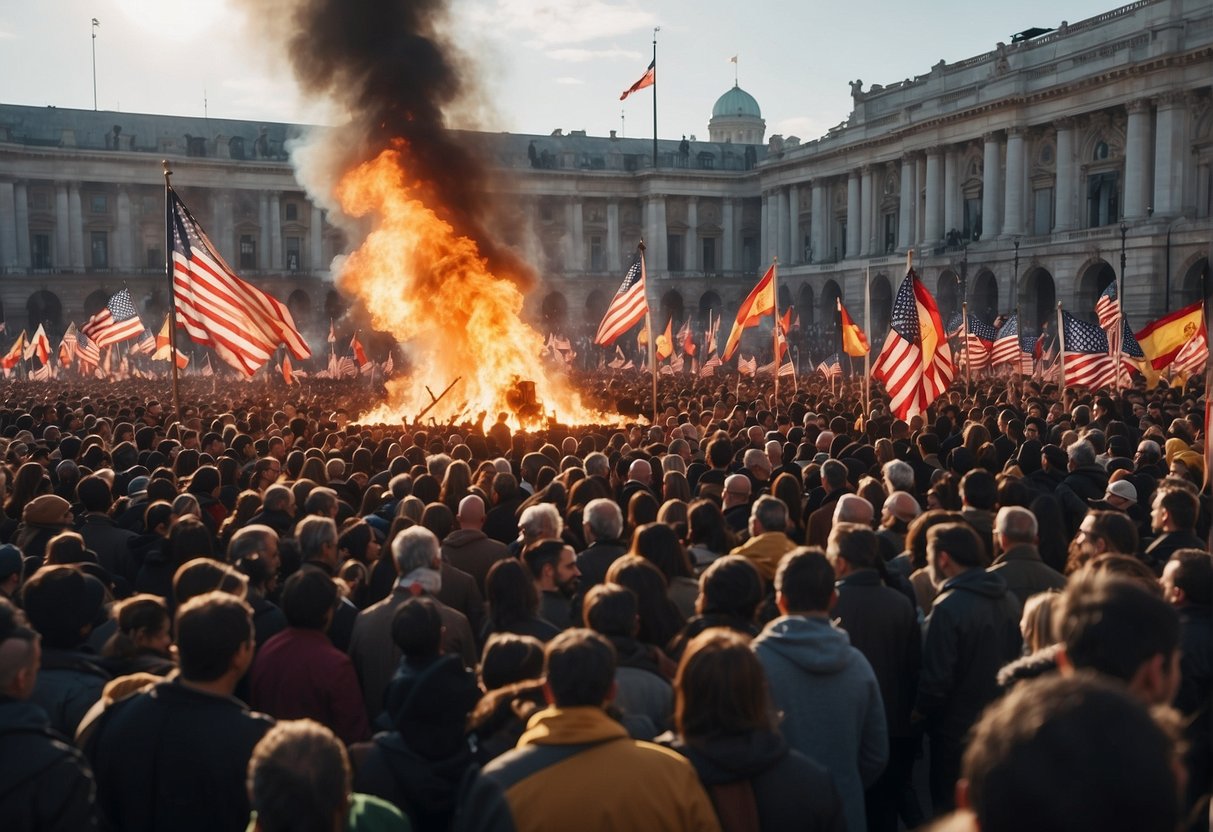
In the vibrant mosaic of democracy, the public square serves as the canvas where citizens paint their thoughts through protest and political expression.
Fanning the Flames: Public Protest and Political Expression
In American history, they’ve seen the flag as a beacon of freedom, and yet, it’s also been the centerpiece of fiery debates — quite literally. When it comes to public protest, the American flag often flutters at the forefront, seen by some as a symbol to revere and by others as an icon ripe for burning. Burning the flag taps into the heart of political expression, with the Supreme Court in Texas v. Johnson (1989) recognizing such an act as a protected form of speech under the First Amendment. Here’s the blazing hot takeaway: burning the ol’ Stars and Stripes may send smoke signals of dissent, but legally, it’s not the barbecue that’s illegal; it’s the context of the blaze that counts.
- Legal precedent: Texas v. Johnson (1989) — Flag burning as symbolic speech
- Criteria for protection:
- Private ownership of flag
- Action as political protest
- Absence of danger to public or property
Burning Questions: Opinion Polls and Public Perception
They may know what the law says, but what does Joe Public think about flag flambé? When they whip out the opinion polls, it’s a rollercoaster of “oohs” and “ahhs” and “No, they didn’t!” Public opinion on flag burning is like a game of tug-of-war between reverence for symbols and support for civil rights. It’s a barbecue where half the guests are ready to roast marshmallows, while the other half wouldn’t dare singe a single stripe. But whether they’re saluting it or setting it ablaze, the punchline is that public perception sways with the political wind, often more fickle than fashion.
- Important facets:
- Emotional response to flag burning
- Balance between patriotism and freedom of expression
- Influence of current events on public sentiment
Cultural Combustion: Flag Burning in the Global Context
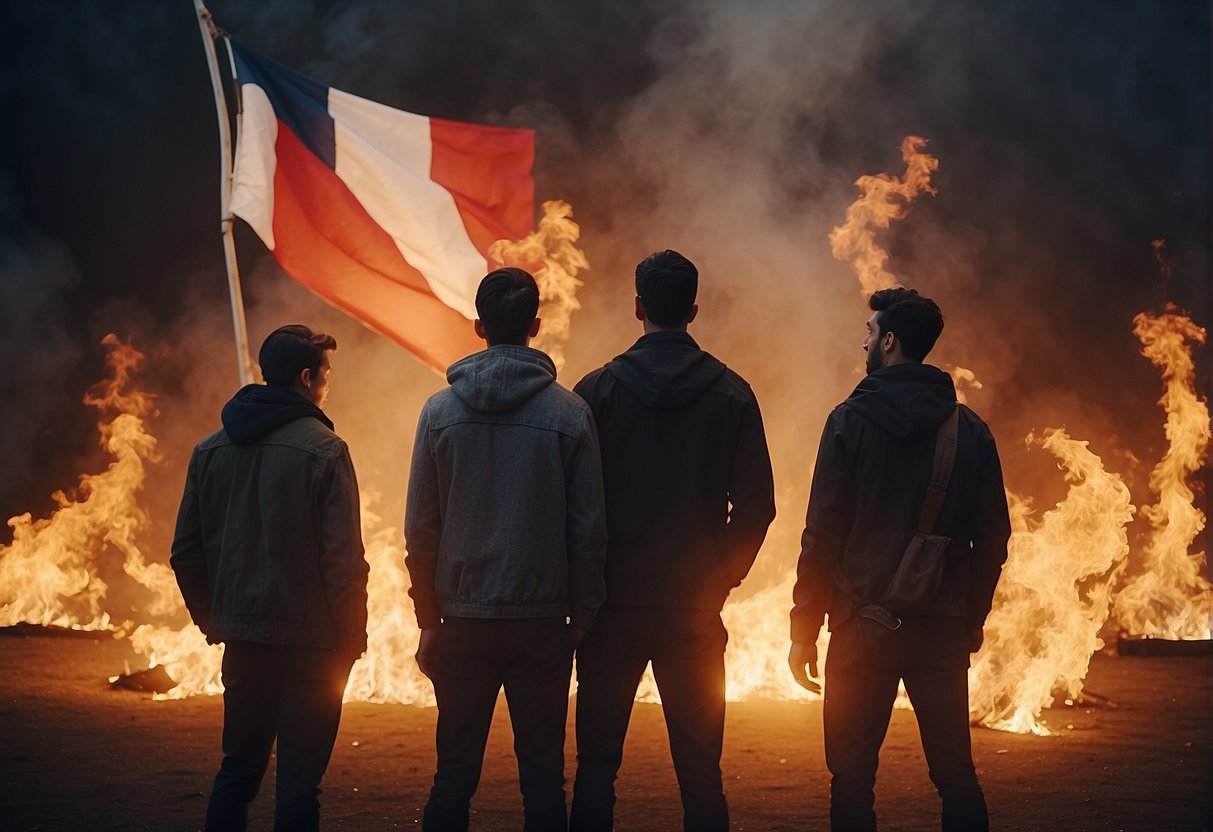
In the tapestry of national symbols, the flag is the ultimate piece of fabric that can spark fiery debates. Now, let’s strike a match and light up the discussion.
An International Inferno: Flag Burning Around the World
Countries around the globe handle the smoldering issue of flag burning with varying degrees of heat. The United States, for example, sees flag burning as a form of symbolic speech protected under the First Amendment, thanks to cases like Texas v. Johnson (1989). Meanwhile, Australia and Canada indulge in the freedom of expression barbecue, allowing the burning of their national flags as a form of protest or dissent.
On the flip side, countries like France have a no-burn policy for their tricolour—setting it aflame can land one in hot water legally. Similarly, Israel and Saudi Arabia prefer their flags served cool and intact, implementing laws that douse any attempts at flag desecration with penal consequences.
| Country | Flag Burning Legal? | Notes |
|---|---|---|
| United States | Yes | Protected under the First Amendment |
| Australia | Yes | Tolerated as a form of protest |
| Canada | Yes | Not penalized legally |
| France | No | Illegal to desecrate the flag |
| Israel | No | Same as France |
| Saudi Arabia | No | Illegal with stringent consequences |
Cultural Wildfire: Symbols, Speech, and Society
The burning of the American flag often sends sparks flying in the realm of national pride, pitting freedom of expression against patriotic fervor. It’s a theatrical demonstration of dissent that can create a spectacle more enthralling than a July Fourth fireworks display.
But this isn’t just about one nation’s star-spangled banner. The flag, for many, stands as a powerful token of identity—if it’s ablaze, so are the passions of the people. The practice of torching this symbol traverses borders, sparking discussions in legal chambers and living rooms alike. And while some view this act as a wildfire threatening societal norms, others see it as a warm hearth where ideas for change are kindled.
In essence, the international perspectives on flag burning swing wildly like a flag in a storm—some drenched in tradition, others whipped by the winds of change. It seems that, like many hotly contended issues, flag burning remains a touchstone that can heat up cross-cultural dialogue or scorch diplomatic ties.
Quenching the Debate: Modern Perspectives and Future Flickers
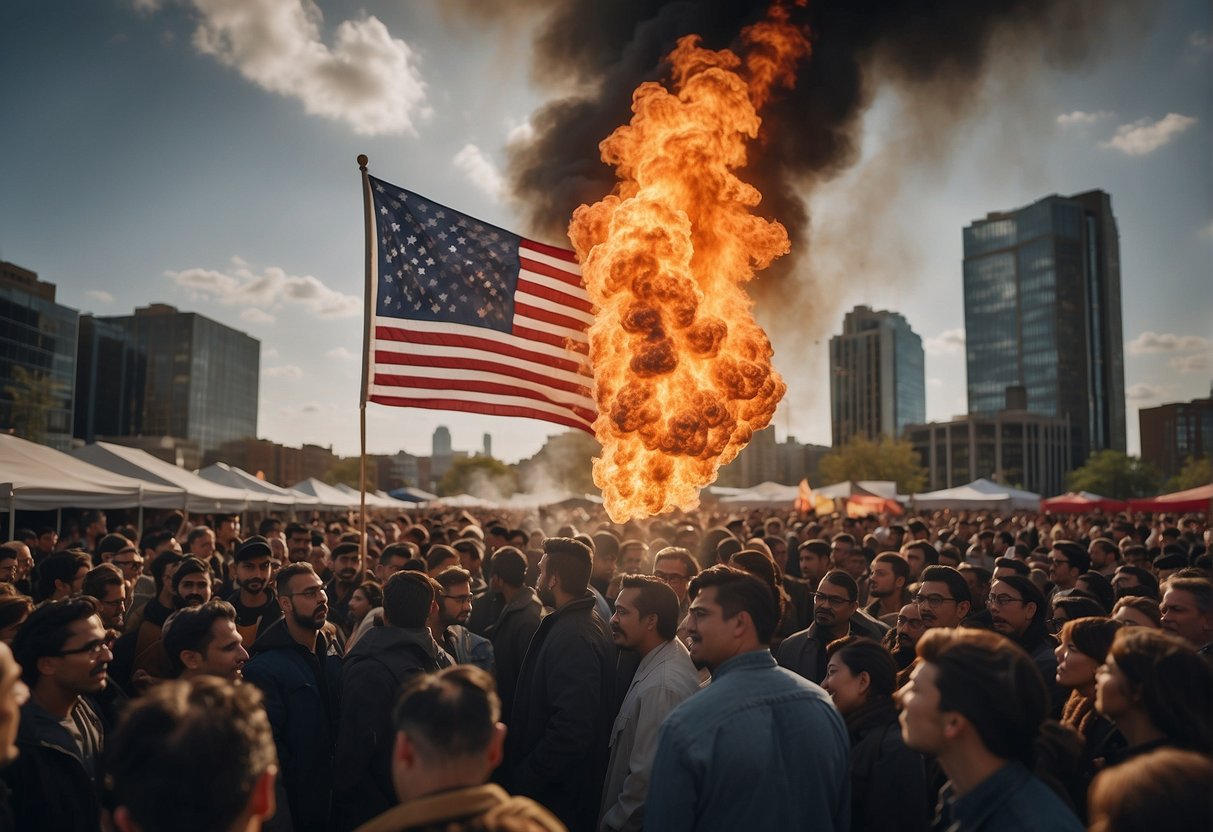
Flag burning, a form of protest that lights up controversy, remains a hot topic in the United States, with opinions flickering across the political spectrum. Some argue it should be as illegal as a three-dollar bill, while free speech advocates say it’s a right that burns bright.
Ronald Reagan, the quintessential American and former commander-in-Grizzly-Bear-Save, professed deep love for Old Glory but, curiously enough, he didn’t call the fire department on flag burners; he believed in the right to express one’s self, perhaps saying “Well, there you go again,” to the very idea of making it illegal.
Antonin Scalia, the late Supreme Court justice known for his originalist flamethrower, fanned the flames when he voted to protect flag burning as free speech, citing the First Amendment—yes, even if he personally found it distasteful, like pineapple on pizza.
Moving on to Hillary Clinton, who co-sponsored the Flag Protection Act of 2005, obviously thought that burning the star-spangled banner should be as ’90s as beepers and frosted tips, showing her appetite for a more moderate roast.
Meanwhile, Donald Trump threw his own log onto the fire, suggesting loss of citizenship or yearlong vacations at the gray-bar hotel for flag burners—an idea that sparked more than a few raised eyebrows, as if caterpillars had discovered coffee.
In an age where political discourse is as predictable as a cat at a laser show, the clash over flag desecration stays ablaze. The debate now sizzles over whether justice should be served with a side of freedom fries, making it crystal clear that the nation’s emblem wrangles as much passion as a surprise comeback in the final seconds of the Super Bowl.



